
Leflunomide
| Contato
Página Inicial

"Cheap leflunomide 20 mg otc, treatment skin cancer".
U. Irhabar, M.B. B.A.O., M.B.B.Ch., Ph.D.
Vice Chair, Georgetown University School of Medicine
These toxicities include symptoms non hodgkins lymphoma buy cheap leflunomide 10 mg online, in order of accelerating severity medicine keppra discount leflunomide 10 mg visa, the following: lingual numbness symptoms quiz leflunomide 20 mg purchase otc, lightheadedness medicine in the 1800s leflunomide 20 mg buy cheap line, muscular twitching, hypotension, unconsciousness, convulsions, coma, respiratory arrest, and cardiac arrest. Adequate registration is then confirmed by making use of the registration device to recognized surface landmarks and visualizing that, when touched, the landmarks correlate with the image on the pc monitor. In our practice, we frequently use the lateral canthus and exterior auditory canal to confirm registration, then run the picture steerage probe alongside the surface of the forehead and nostril to assess for the accuracy of depth. If this accuracy is insufficient, reregistration or the utilization of additional registration points could additionally be required. This incision should bear in mind not just the size of the tumor however should be long enough to accommodate a craniotomy with acceptable publicity for speech or language mapping. Supraorbital / Supratrochlear-Palpate the supraorbital notch and insert needle perpendicular to inject. Inject from the nasal root to the midpupillary line to cowl both nerve distributions B. This is 1cm anterior to the tragus of the ear, just above the temporomandibular joint. Inject just medial to the occipital artery to the midline alongside the nuchal line to the occipital protuberance. Inject behind the ear from the top-down after which proceed medially along the superior nuchal line to the greater occipital nerve injection web site. Greater Auricular-inject 2cm posterior to the ear at the stage of the zygomatic root or tragus. The block is done bilaterally and prior to placement of the headframe or neuromonitoring scalp electrodes. Once marked, additional local anesthetic ought to be injected along the incision line. By administering these diuretics at this level within the surgical procedure, we are ready to assure maximal mind leisure at the time of dural opening, usually 30�40 min later. In doing so, we reduce the chance of brain herniation out our opening, venous bleeding because of venous cortical compression, and ischemia due to compression at the bony margins. The patient stays asleep during the opening incision, retraction of the scalp flap, and craniotomy. Once the dura is uncovered, ultrasound could additionally be used to further localize the tumor and serve as a form of real-time picture steerage pre- and post-resection to decide if gross residual disease stays. Additional discount in intracranial strain may be obtained by administering further aliquots of mannitol. Lowering the intracranial strain prior to dural incision reduces the risk of mind herniation by way of the dural opening. The dural incision is painful for the affected person and not mitigated by any of the preoperative local anesthesia. The cottonoids are then removed and the dura is irrigated with saline to remove extra native anesthetic. When possible, the patient should only be aroused after completion of the durotomy to reduce conscious painful stimulation. Inexperience with any member of the team can outcome in issues that negate any good factor about performing the process awake (Table 3). Intraoperative mapping and stimulation/electrocorticography Once the dura is open and the patient is awake, neuropsychological testing can start. At our establishment, we use the Ojemann Cortical Stimulator (Integra Neuroscience, New Jersey), beginning with a current of 2 mA applied over 3�4 s. The present is progressively elevated to elicit both speech arrest or motor arrest through the performance of a task ("optimistic mapping"). The absence of speech or motor arrest, so-called "adverse mapping," is valuable as properly, as it can signify an area of safe resection. If the neurophysiologist notices after-discharges-electrical discharges recorded after termination of the stimulus-stimulation should be halted and the stimulus current may need to be decreased. If an arrest is witnessed in conjunction with an after-discharge, it could be very important reevaluate this area, as the arrest could additionally be due to the after-discharge quite than the direct stimulation. If the seizure persists, consideration of pharmacologic intervention in the form of extra antiepileptic doses, intravenous benzodiazepines, or other drugs should be thought-about. Once the after-discharge threshold is set, we then set our stimulation present for the tumor resection 2 mA beneath the after-discharge threshold however not to exceed a 12 mA most. As the resection proceeds, motor and language testing continues to monitor for model spanking new neurologic deficits. The surgeon can also elect to stimulate subcortically to investigate these areas for potential perform. For subcortical mapping, we use the identical stage of stimulus as for cortical mapping, although the current might need to be increased barely. As a common rule for white matter mapping, we discover that for each 2�4 mA of stimulation with no neurophysiological response confers a region of safe resection across the stimulation website of 5�10 mm in diameter. Positive and unfavorable mapping Traditionally, it was believed that enormous craniotomies incorporating definitive areas for positive mapping had been wanted to accurately delineate areas of secure surgical resection. With respect to language operate, negative mapping, or the absence of a stimulation-induced speech arrest, can identify areas by which surgical resection is secure and could be as helpful as positive mapping. In this case, the affected person is supine with head turned barely to the best in a cushty place and with a warming blanket to minimize shivering. The neuromonitoring technician is positioned subsequent to the Ojemann stimulator generator to modify stimulation as necessary throughout the process and to present neurophysiological suggestions to the group as the surgical procedure progresses. In this photograph, the surgeon is utilizing the navigation probe to determine the inferior margin of the tumor based mostly on the T2W pictures visualized on the neuronavigation monitor at the foot of the mattress. Given the extra homogeneous localization of motor operate to the precentral gyrus, figuring out an area of constructive stimulation provides increased confidence in the safety of the deliberate resection. In this process, a strip electrode is positioned on the cortex in an orientation perpendicular to the presumed orientation of the central sulcus. Phase reversal is identified when the negative N20 peak is replaced by a constructive P20 peak between two electrodes on the contact array. These instruments help the surgeon with figuring out anatomical constructions and correlating them with radiographic findings. Neuronavigation and intraoperative imaging are actually commonly used to help with this. Chemiluminescence is another approach being more and more utilized by neurosurgeons to help in the visual discrimination of neoplastic tissue from normal mind parenchyma, allowing for a more full tumor resection when visible discrimination under a microscope becomes tough. And lastly, newer intraoperative tools for tumor ablation are being investigated which will end in less invasive craniotomies while on the similar time doubtlessly minimizing the likelihood of tumor recurrence or development. Neuronavigation Image-guided stereotactic craniotomy is a term used routinely when discussing virtually any type of surgical procedure for a main mind tumor within the developed world. In such instances, the surgeon can use the navigation imaging instruments to guide the resection of the mass while avoiding critical functional constructions also seen on the navigation imaging. This reregistration then fuses the model new pictures to the system and now offers picture guidance based mostly on the new image units that now account for the shift that has occurred with extreme accuracy. This permits the surgeon to overcome the restrictions of mind shift and guarantee an correct resection prior to awakening the patient from anesthesia. Chemiluminescence for resection of low-grade gliomas In the previous decade, there has been growing interest in the use of intravenous chemiluminescent agents that are preferentially taken up by or bind to neoplastic cells relative to regular cells of the mind parenchyma. Such brokers, in theory, when appropriately uncovered to the correct wavelength of sunshine preferentially "light up" tumor cells compared to regular mind cells permitting the surgeon to then take away the abnormally visualized tissue. Its function in intraoperative fluorescence-guided resection of distinction enhancing malignant gliomas has been established, with reviews demonstrating improved extents of resection and resultant elevated progression-free survival. Image steerage instruments could also be used to assess the extent of resection, with the caveat that brain shift from tumor resection and cerebrospinal fluid egress will decrease its intraoperative accuracy. If ultrasound was used previous to the resection, it could once more be employed to determine residual hyper- or hypoechoic areas relative to regular brain parenchyma that could denote residual tumor. This approach may be complicated by the reality that blood products and adjoining injured or contused mind can create hyperechoic regions which might be sonographically difficult to distinguish from tumor. This permits for the determination of tissue that has been heated sufficiently to cause necrosis and cell dying. The major limitations of this technique with respect to glioma surgical procedure are its absence of long-term outcomes compared to normal surgical resection in addition to the shortcoming, at this level, to be included in clinical trials after this procedure. Postoperative management After surgical resection, there are a number of treatment algorithms.
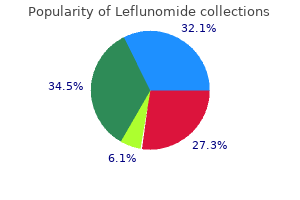
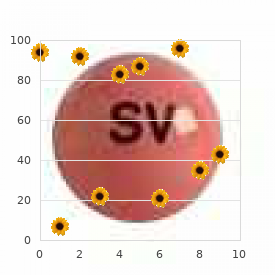
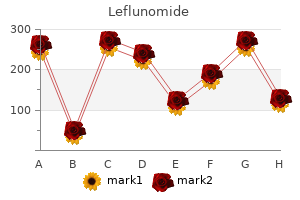
Along with other salivary glycoproteins medications an 627 cheap 10 mg leflunomide with amex, statherin and sure proline-rich proteins bind to the tooth floor symptoms torn meniscus cheap leflunomide 10 mg, forming the acquired enamel pellicle nature medicine generic leflunomide 10 mg amex. The ensuing supersaturation of the calcium and phosphate reduces dissolution and promotes remineralization of the tooth enamel medications like adderall 10 mg leflunomide discount with mastercard. On the floor of the tooth, a high focus of calcium and phosphate causes posteruptive maturation of the enamel, will increase surface hardness and resistance to demineralization. Remineralization of the preliminary carious lesions can be enhanced by fluoride ions in saliva. They are mainly produced by the serous secretor cells of both major and minor salivary glands. Some excessive molecular weight salivary glycoproteins aggregate particular strains of oral microorganisms and/or forestall their adhesion to oral tissues, thus facilitating their oral clearance. The acinar cells secrete peroxidase and ductal system secretes thiocyanate, each of which establish a bactericidal system in saliva. Another antibacterial protein in saliva is lysozyme, an enzyme that hydrolyzes the polysaccharide of bacterial cell walls, leading to cell lysis. A profound amount of these antioxidants is secreted by the parotid gland during meal instances. There is an extra glycoprotein produced by the parenchymal cells, referred to as secretory element, which is also part of the secretory IgA molecule. Secretory part appearing as a receptor within the parenchymal cell membrane for dimeric IgA, facilitates the transfer of the IgA to the lumen, both by translation in the cell or by the endocytosis and secretion together with the secretory products of the parenchymal cells. Secretory part can also enhance the resistance of the IgA molecules to denaturation or proteolysis within the oral cavity. Small amounts of IgG and IgM have also been detected in saliva, and occasional plasma cells in the glandular stroma could be stained by fluorescent antibodies specific for these immunoglobulins. Salivary immunoglobulins might act primarily through their capability to inhibit the adherence of the micro-organisms to the oral tissues. Another antibacterial substance found within the saliva is lactoferrin, an iron-binding protein. Digestion Saliva participates in digestion by providing a fluid setting for solubilization of food and taste substances, and through the action of the digestive enzymes, principally amylase have been identified in human beings; two of those, representing 25%�30% of the total amylase protein, have small amounts of certain proteins. The motion of amylase on ingested carbohydrates to produce glucose and maltose begins within the mouth and continues for up to 30 minutes within the abdomen earlier than the amylase is inactivated by the acid pH and proteolysis. Lingual lipase produced by lingual serous glands initiates the digestion of dietary lipids, hydrolyzing triglycerides to monoglycerides, diglycerides, and fatty acids. Other hydrolytic enzymes have been detected in saliva, however their significance in food digestion has not been established. Mastication and deglutition Saliva moistens the food and helps its breakdown into smaller particles to initiate digestion. The moistening and lubricating properties of saliva enable the formation of bolus and facilitate deglutition. Saliva not only moistens the dry meals but in addition reduces the temperature of the new foods. Taste notion the meals taken into the oral cavity is emulsified in saliva and dissolved. Speech Saliva retains the oral tissue moist and well lubricated, which facilitates speech. Tissue restore A variety of progress factors and trefoil proteins are present in small quantities in saliva. Under experimental conditions these promote tissue growth, differentiation, and wound therapeutic. Excretion the salivary glands have an excretory function as do pancreas and gastric glands. Many substances from blood reach the saliva, thus saliva could be considered as a route of excretion. The low molecular weight serum constituents may be demonstrated in saliva, for example, electrolytes and drug concentrations, which could be assessed within the saliva. The nitrates within the food reach the saliva and are lowered to nitrites by microorganisms, that are thought-about to be necessary in carcinogenesis. Buffer capability and Bicarbonate, phosphate, calcium, statherin, proline-rich remineralization anionic proteins, fluoride 6. Excretion (Through) water Clinical considerations An understanding of the anatomy, histology, and physiology of the salivary glands is essential for good scientific practice. In all features of scientific follow, salivary glands and saliva play an important position. Saliva regulates the oral surroundings and has widespread distribution of the salivary glands in the oral cavity. With the exception of a portion of the anterior part of the exhausting palate, salivary glands are seen all over the place in the oral cavity. Because of this function, salivary gland lesion can occur all over the place in the oral cavity. In the differential diagnosis of oral lesions subsequently, a salivary gland origin for a pathology must always be saved in thoughts. These embrace inflammatory infective diseases corresponding to viral, bacterial, or allergic sialadenitis, a wide selection of benign and malignant tumors, autoimmune diseases such as Sj�gren syndrome, and genetic ailments corresponding to cystic fibrosis. One of the most common surface lesions of the oral mucosa is a vesicular elevation referred to as mucocele. This is produced from the severance of the duct of a minor salivary gland and pooling of the saliva within the tissues. A blockage of a salivary gland duct might occur after formation of a mucous or calcified plug throughout the duct. If this happens in a minor salivary gland, it often causes no signs, however in major glands such obstruction could be very painful and may require surgical intervention. In this, the onerous palate is whitened by hyperkeratinization across the duct opening of minor salivary gland brought on as a result of heat from tobacco use. Hence, clinically these are seen as purple macules scattered on white background of the palatal mucosa. The salivary glands may be affected by quite lots of systemic and metabolic illnesses. The major glands, particularly the parotid, may become enlarged throughout hunger, protein deficiency, alcoholism, pregnancy, diabetes mellitus, and liver illness. The association of the most important salivary glands with the cervical lymph nodes, led to by a common space of growth, necessitates the differentiation of pathologic circumstances of those lymph nodes from salivary gland ailments. Alteration of salivary gland operate during illness states may have profound influences on the oral tissue. Loss of salivary operate or discount in quantity of saliva secreted known as xerostomia, which results in dryness of the mouth. The causes of xerostomia embody disease states like Sj�gren syndrome, results of chemotherapy or radiation therapy, or on account of variety of medications. The frequent drugs causing dry mouth are anticholinergics, antidepressants, antipsychotics, antihypertensives, anoretics, and medicines used within the treatment of parkinsonism. Decreased salivary volume leads to difficulty in speech, mastication and style perception, and swallowing turns into painful. Oral tissues turn into susceptible to frequent oral infection; irritation and ulceration of oral mucosa is commonly seen. In some cases, excessive salivary secretion is seen due to sure physiologic states and uncommon pathologies. Thus, indicators and symptoms of salivary dysfunction should be accurately recognized and treated. Age adjustments in the salivary glands, notably distinguished in the parotid, include a gradual replacement of parenchyma with fatty tissue. Since the parotid is the major supply of serous saliva; with advancing age, sufferers often complain of dryness and a rise in the viscosity of saliva. Recent research have shown that in the aged, the move of saliva is decreased during resting situation, but in composition and amount stimulated saliva in wholesome, aged people is similar to that of younger adults. Salivary gland and sialochemistry are often of worth in the analysis of glandular and systemic ailments. It is valuable in diagnosing ailments like cystic fibrosis, Sj�gren syndrome, and certain infectious diseases associated with Helicobacter pylori, like peptic ulcer disease and chronic gastritis.
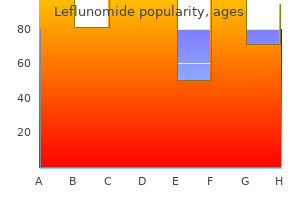
Therefore medications during childbirth generic leflunomide 10 mg overnight delivery, the right reply is either the one one associated to parasympathetic overdrive of these body regions treatment models discount leflunomide 20 mg with visa. For example bad medicine leflunomide 10 mg low price, tachycardia is inaccurate because parasympathetic viscerosomatic reflexes contribute to bradycardia for the center symptoms diabetes type 2 order 20 mg leflunomide. Answer: D Stimulation of the vagus nerve prompts the parasympathetic nervous system. For example, parasympathetic stimulation of the gastrointestinal tract causes relaxation of sphincters and an increase in motility to promote digestion. Parasympathetic stimulation of the center will slow down the heart fee and decrease contractility. Answer: A You ought to identify that this affected person has acute appendicitis after which decide what parasympathetic viscerosomatic reflex is related to this. All of the other answer decisions need to do with sympathetic viscerosomatic reflexes. Answer: C Sympathetic function of the gastrointestinal tract is related to leisure of the graceful muscle of the lumen, contraction of sphincters, and a decrease in secretions and motility. The sympathetic nervous system additionally stimulates gluconeogenesis of the liver and glycogenolysis to provide extra available power to cells and muscles. These reflex points are easy, firm, discretely palpable nodules, roughly 2-3 mm in diameter, located inside the deep fascia or on the periosteum of a bone. They are generally located posteriorly within the tissues adjacent to the spine and anteriorly typically in segmentally related tissues. Likewise T3 /T4 implies between the transverse process of T3 and T4, halfway between the transverse and spinous course of. The proximal transverse colon at the hepatic flexure is situated at the proper distal femur. The distal transverse colon at the splenicflexure is situated at the left distal femur. It is painful upon compression and may give rise to a characteristic referred pain, tenderness, and autonomic phenomena. Diagnostic traits the patient might complain of tightness or soreness in a particular muscle that may or may not have adopted an harm. Upon compression of the band, the patient will expertise ache at the website and pain referring to an area of the physique. For example, trigger factors situated inside the sternocleidomastoid will refer ache to occipital and temporal regions ipsilaterally. Pathophysiology the spinal cord plays an essential function in the institution and maintenance of set off factors. Direct stimuli, similar to a muscular strain, overwork fatigue, or postural imbalance, can initiate set off points. For instance, if a person have been to strain his deltoid, irregular and steady sensory input from the overstretched muscle spindle will sensitize the interneurons at C5. A reflex occurs so that muscle pressure is produced within the deltoid on the initiating website, leading to a taut band. Other stimuli, similar to visceral dysfunction, can also facilitate the spinal twine (viscero-somatic reflex). For example, sixty-one percent of sufferers with cardiac disease had been reported to have chest muscle trigger points. All techniques are directed toward eliminating the set off point using a neurological or vascular method. Some authors notice a significant overlap in the location between set off factors and tenderpoints, forty one whereas some authors state that their distinction is considerably arbitrary. Physical examination reveals his heart has a regular fee and rhythm with no murmers. Osteopathic structural examination reveals a group exhalation dysfunction of ribs 4-9. A 20-year-old female presents with nasal congestion, rhinorrhea, and maxillary sinus strain ongoing for two weeks. An obese 40-year-old feminine presents with proper upper quadrant pain when she ingests fatty meals. Answer: A Tenderpoints are small tense edematous areas of tenderness in regards to the measurement of a fingertip. Answer: A the proper or ascending colon corresponds to the right iliotibial band while the left or descending colon corresponds to the left iliotibial band. The cecum point is positioned on the right proximal femur, the proximal transverse colon on the right distal femur, the sigmoid colon at the left proximal femur, and distal transverse colon on the left distal femur. There have been case reviews of cessation of those rhythms with appropriate remedy of the related set off level. Trigger factors are the only kind of tenderpoint which refer ache elsewhere within the body. Answer: E this patient likely has biliary colic considering she meets the pathognomonic. Still and his early students, which engages continua] palpatory suggestions to obtain release of myofascial tissues. Counterstrain, facilitated positional release, unwinding, balanced ligamentous launch, practical indirect launch, direct fascia] launch, cranial osteopathy, and visceral manipulation are all types of myofascial launch. Myofascial release treatment may be direct or indirect, energetic or passive (see Chapter 1, for an extra clarification of these kind of treatment). It additionally can be carried out anyplace from head to toe, as a result of fascia surrounds and compartmentalizes all structures all through the body. For this purpose, there are a quantity of different types of myofascial release techniques. The doctor palpates the patient with just enough strain to have interaction the skin and subcutaneous fascia] tissues. Then moves the tissues through x and y axes so as to determine the direction of restriction an direction of fascia] ease (sometimes referred as a tight-loose or ease bind concept). After figuring out the barriers, the physician must then decide the sort of treatment (direct or indirect). Occasionally, the physician can use a combined approach, where one hand apurpose the tight barrier and the opposite the unfastened barrier. In addition, the doctor could alternate between the tissues in a "impartial" level between the obstacles (similar to functional technique). For extra data of useful technique check with Foundations of Osteopathic Medicine third version Chapter 52 Determine lively or passive therapy. Once the myofascial tissues are engaged with respect to the specified barrier, the physician can then resolve to use patient assistance (active treatment) or encourage affected person to continue to chill out (passive treatment). Some forms of active therapy ask the affected person to perform isometric muscle contractions (clenching fists or jaw), tongue or ocular movements, or inhalation/ exhalation. A launch might are available many types, a change in temperature, a tightness might "melt" or "give way. The release phenomena is delicate and can solely be appreciated by the skilled practitioner. Therefore, it may take a number of makes an attempt earlier than the osteopathic pupil can experience the discharge phenomenon. The physician follows this change and continues to follow the fascial motion until no additional evidence of creep happens. The doctor reevaluates the tissues to determine if the fascia] restriction has improved. Goal of myofascial release 1 P707 In general myofascial launch methods assist: Restore motion in somatic dysfunction Relieve edema Relieve pain Improve circulation and lymphy flow Support visceral perform 204 Chapter 12 Myofascial Release C. It is essential to do not forget that a goal of myofascial release is to improve lymphatic flow. Therefore, several of the indications and contraindications of lymphatic treatments could be applied to myofascial launch methods. For an inventory of indications and contraindications of particular myofascial launch techniques, please see Appendix A. Fascial Patterns (Common Compensatory Patterns) Many authors have noted that the musculoskeletal system in most individuals is uneven. Gordon Zink, D0 was the first to provide documented materials about these fascia] preferences.
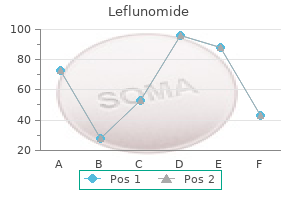
Syndromes
- The face is well formed.
- Time of the bite
- Vomiting, may be bloody
- Pentamidine
- Nausea, vomiting, and sweating often occur.
- Lonox
- Brain tumor
- Symptoms get worse
- Partial webbing or fusing of fingers or toes
- Tumor of the blood vessels or around the heart
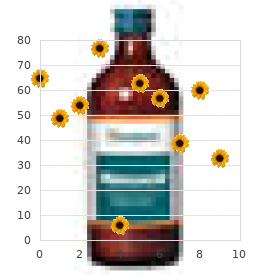
Synthetic materials carry no danger of illness transmission or immune system rejection medicine go down leflunomide 10 mg generic mastercard. Guided tissue regeneration Guided tissue regeneration method has developed medicine kit leflunomide 20 mg order free shipping, which is an epithelial exclusionary method symptoms lyme disease order leflunomide 20 mg without prescription. This technique facilitates the cells of the periodontal ligament to differentiate into osteoblasts medicine on time 20 mg leflunomide overnight delivery, cementoblasts, and fibroblasts leading to regeneration of the lost periodontium. It includes use of membranes, nonresorbable and/or resorbable, which forestall the downgrowth of the epithelium thereby promoting regeneration. Biologically mediated methods Biologically mediated strategies include materials, such as enamel matrix proteins, that can be premixed with automobile solution. They are supposed as an adjunct to periodontal surgery for topical software onto exposed root surfaces or bone to deal with intrabony defects and furcations as a outcome of reasonable or severe periodontitis. Enamel matrix proteins go away only a resorbable protein matrix on the basis surface, which makes bone extra likely to regenerate. Bone tissue engineering has emerged as a new therapeutic different to promote bone therapeutic. This approach aims to regenerate or restore bone tissue with numerous combos of polymeric scaffolds, cells, and inductive factors into a system that actively stimulates tissue formation. Scaffolds are of two types, particularly, those which simply information and help bone regeneration-osteoconductive, and those which actively stimulate bone regeneration via the delivery of inductive factors-osteoinductive. These scaffolds are a porous composite materials composed mainly of hydroxyapatite in a collagen type I matrix. These supplies promote osteoblasts and osteoprogenitor cell attachment and differentiation to enhance bone tissue formation. Other materials used for bone tissue engineering embody synthetic, biocompatible, and biodegradable polymers similar to poly (lactide-coglycolide). For filling small defects, injectable polymers such as alginate or polyethylene glycol are preferred. Osteoblasts and osteoprogenitor cells have been integrated into varied scaffolds to enhance bone repair. Stem cells derived from bone marrow periosteum, adipose tissue, skeletal muscle, or baby tooth could be induced to differentiate into various cell types corresponding to muscle, nerve, cartilage, bone, and fat. Direct or gene remedy approaches to the delivery of osteoinductive factors are also promising approaches for bone regeneration. Controlled launch of proteins from a polymeric scaffold permits localized sustained protein supply and could also be a more effective means to improve bone formation. Summary Bone is a mineralized connective tissue with a comparatively flexible character and compressive energy. The property of plasticity allows it to be remodeled in accordance with the functional demands positioned on it. Classification of bones Bones are categorized as lengthy, short, flat, and irregular based on the form. They are additionally termed mature, immature, compact, and cancellous depending on the microscopic structure. Based on their development, bones are categorised as endochondral and intramembranous. Inorganic and natural constituents of bone the mineral element of bone is predominantly made up of hydroxyapatite crystals. The organic element is predominantly made up of sort I collagen followed by kind V collagen and noncollagenous proteins. Histology of bone All bones are made up of an outer compact bone and central medullary cavity. Osteon is the basic metabolic unit of bone, which is made up of a central haversian canal surrounded by concentric lamellae. Circumferential lamellae are present on the periosteal and endosteal surfaces in parallel layers. Regularly appearing resting traces, which denote the remainder interval, and irregularly showing reversal strains denoting the junction between bone resorption and bone formation are seen. Osteoblasts Osteoblasts are plump cuboidal cells having all of the organelles for protein synthesis. Osteocytes After completion of the perform, osteoblasts stay on the surface as lining cells or get entrapped within the matrix, to become the osteocytes. Osteocytes have an interconnecting system via canaliculi with the overlying osteoblasts and neighboring osteocytes, thus maintaining the vitality and integrity of bone. Osteoclasts Osteoclasts are the bone-resorbing cells derived from hemopoietic cells of monocyte�macrophage lineage. They develop a ruffled border and an area devoid of organelles referred to as sealing zone close to the resorbing floor of bone. In intramembranous bone formation, bone is immediately formed within a vascular, fibrous membrane. Intramembranous bone formation In intramembranous bone formation, bony spicules that form initially develop and unite to form trabeculae, which extend in a radial direction enclosing blood vessels. It has intertwined collagen fibers and a decrease mineral density compared to mature bone known as lamellar bone, which has an orderly arrangement of collagen fibers and the next mineral content material. Endochondral bone formation In endochondral bone formation, the cartilage grows by interstitial and appositional progress. Capillaries grow into the cartilage and the inner cellular layer of the perichondrium differentiates into osteoblasts which type bone. The bone along with blood vessels referred to as periosteal bud types the primary ossification heart. The medullary cavity is produced by osteoclastic resorption and secondary ossification centers containing cartilage stay on the growing ends of bone or the epiphyses. Mineralization of bone Various components contribute to situations which will favor calcification. Booster mechanism proposes a neighborhood increase in phosphate and calcium degree, whereas in seeding mechanism, certain substances act as seed to attract calcium or phosphate ions. Theories that have been put ahead to explain the mechanism of calcification are nucleation theory primarily based on seeding mechanism, and alkaline phosphatase concept primarily based on booster mechanism and matrix vesicle concept. In matrix vesicle principle, matrix vesicles, which accumulate calcium and kind amorphous calcium phosphate within them, lay down apatite in relation to collagen fibrils; phosphoproteins, like osteonectin, assist on this process. The free natural and inorganic particles are endocytosed by osteoclasts and packed into membranebound vesicles and released by exocytosis. Bone transforming In order to preserve stability and integrity of bone, it continually undergoes transforming. After the activity ceases, osteoblasts lay down bone forming new haversian systems called filling cones. Markers for bone turnover the important markers for bone turnover embody serum alkaline phosphate for bone formation, urinary calcium and hydroxyproline for bone resorption, and serum 2 microglobulin for bone transforming Alveolar bone Alveolar course of is a part of the maxilla and mandible that types and supports the sockets of the tooth. The alveolar bone correct is also referred to as cribriform plate as a result of many vessels and nerves penetrate it. Supporting alveolar bone the supporting alveolar bone consists of cortical plates and spongy bone. Alveolar bone formation and resorption Due to steady eruption of teeth referred to as physiological mesial drift, alveolar bone undergoes internal reconstruction; bone types on the distal side and resorbs on the mesial aspect. In the therapeutic of fractures, a bony callus is shaped, which is an embryonic sort of bone with less amount of calcified intercellular substance. Alveolar course of is resorbed in periodontal disease and is each of horizontal and vertical types. Therapeutic considerations Bone grafts or artificial supplies are used to fill the bony defects and provide structural help. In guided tissue regeneration, materials like collagen are used to help pure bone formation processes. Enamel matrix proteins have been used as an adjunct to periodontal surgical procedure for topical software onto exposed root surfaces or to treat intrabony defects. Bone tissue engineering is a new therapeutic method for bone regeneration using a combination of polymeric scaffolds, osteogenic cells, and osteoinductive factors.
Generic leflunomide 10 mg on line. Mononucleosis.